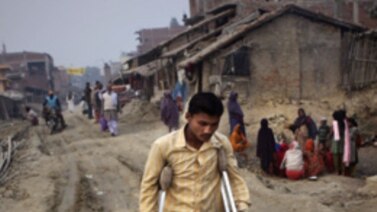
From VOA Learning English, this is Science In The News. I'm Faith Lapidus.
And I'm Bob Doughty. This week, we explore the science of tornadoes. Weather experts say tornadoes are the most violent of all atmospheric storms. They strike in many parts of the world, including the United States.
Tornado season has begun in the United States.
A series of violent storms moved through north-central Texas in the middle of May. Some storms struck the small community of Granby, south of the Dallas-Fort Worth area. At least six people were killed. The tornadoes flattened or caused heavy damage to many homes.
Less than a week later, a large tornado caused major damage in the neighboring state of Oklahoma. The three kilometer wide tornado destroyed homes, businesses and two schools in Moore, just outside Oklahoma City. Officials say the storm left more than 20 people dead, and injured more than 200 others.
In May 1999, another deadly tornado hit Moore. It was one of more than 70 tornadoes reported in Oklahoma and Kansas in just 21 hours.
A tornado is a violently turning tube of air suspended from a thick cloud. It extends from a thunderstorm in the sky down to the ground. The shape is like a funnel: wide at the top, narrower at the bottom.
Tornadoes form when winds blowing in different directions meet in the clouds and begin to turn in circles. Warm air rising from below causes the wind tube to reach toward the ground. Because of their circular movement, these windstorms are also known as twisters.
The most severe tornadoes can reach wind speeds of 320 kilometers an hour or more. The resulting paths of damage can be up to three kilometers wide, while the smallest widths are less than 10 meters. In some cases, the paths of damage can extend more than 480 kilometers.
With a tornado, bigger does not necessarily mean stronger. Large tornadoes can be weak. And some of the smallest tornadoes can be the most damaging. But no matter what the size, tornado winds are the strongest on Earth. Tornadoes can carry trees, cars and homes from one place to another. They can also destroy anything in their path.
Tornadoes have been observed on every continent except Antarctica. But experts say they are most commonly seen in the United States. On average, more than 1,000 are reported nationwide each year.
The National Oceanic and Atmospheric Administration keeps records of tornado sightings. It says tornadoes kill 70 people and injure 1,500 others nationwide in an average year.
Tornadoes are observed most often in the center of the United States, where the land is mostly flat. The area where the most violent tornadoes usually happen is known as “Tornado Alley.” This area extends from Texas to South Dakota between the Rocky Mountains and the Appalachians.
Tornadoes can happen any time of the year. But most happen from late winter to the middle of summer. In some areas, there is a second high season in autumn. Tornado seasons are the result of wind and weather patterns. During spring, warm air moves north and mixes with cold air remaining from winter. In autumn, the opposite happens. Cold weather moves south and combines with the last of the warm air from summer.
Tornadoes can strike with little or no warning. Most injuries happen when flying objects hit people. Experts say the best place to be is in an underground shelter, or a small, windowless room in the lowest part of a building.
People driving during a tornado are advised to find low ground and lay flat, facedown, with their hands covering their head. People in the path of a tornado often just have minutes to make life-or-death decisions.
The deadliest American tornado on record was the Tri-State Tornado of March 18, 1925. It tore across Missouri, Illinois and Indiana. Six hundred ninety-five people were killed.
Between March and May of 2011, there were 1,159 confirmed tornadoes across the United States. Scientists say that is the most on record for any three-month period. The most active month was April 2011, when 758 tornadoes were confirmed. That is the most ever for any month.
That April, the country broke a 37 year old record for the largest tornado outbreak. A “tornado outbreak” is commonly defined as six or more tornadoes produced by the same weather system within a day.
Scientists say the 199 tornadoes on April 27, 2011, were the most for any single day. They say the storms killed 316 people – the most ever in modern records for a 24 hour period.
No two tornadoes look exactly the same. And no two tornadoes act the same way. Even a weak tornado requires the right combination of wind, temperature, pressure and humidity. Weather experts can identify these conditions. And, when they observe them, they can advise people that tornadoes might develop. But they are not able to tell exactly where or when a tornado will hit. Tornado warnings still depend in large part on human observations.
Usually a community will receive a warning at least a few minutes before a tornado strikes. But each year there are some surprises where tornadoes develop when they are least expected.
The tornado reporting system involves watches and warnings. A tornado watch means tornadoes are possible in the area. A tornado warning means that a tornado has been seen. People are told to take shelter immediately.
Yet tornadoes can be difficult to see. Sometimes only the objects they are carrying through the air can be seen. Some night-time tornadoes have been observed because of lightning strikes nearby. But tornadoes at night are usually impossible to see. Tornadoes that form over water are called waterspouts. But tornadoes cover a much smaller area than hurricanes, which form over oceans.
Tornadoes can be measured using wind speed information from Doppler radar systems. Tornadoes usually travel in a northeasterly direction, but they have been known to move in any direction. The average forward speed is about 50 kilometers an hour. But they can have a forward speed of up to 115 kilometers an hour. Or they may not move in any direction.
In the United States, the force of a tornado is judged by the damage to structures. Scientists inspect the damage before they estimate the severity of a tornado. They measure tornadoes on the Enhanced Fujita, or EF, scale.
Ted Fujita was a weather expert who developed a system to rate tornados in the 1970s. The EF scale involves wind estimates based on levels of damage to 28 different kinds of structures and other objects. Tornadoes that cause only light damage are called an EF-zero. Those with the highest winds that destroy well-built homes and throw vehicles great distances are called an EF-five.
Some people make a sport out of watching and following tornadoes. They are called tornado chasers or storm chasers. Their work can be seen in the extreme weather videos that are popular on television and the Internet.
Some chasers do it just because it is their idea of fun. Others do it to help document storms and warn the public. Still others are part of weather research teams.
A few years ago, an international team of scientists completed a tornado research project called VORTEX2. More than 100 researchers traveled throughout America’s Great Plains in 2009 and 2010. They used weather measurement instruments to collect scientific information about the life of a tornado. The goal of the project was to examine in detail how tornadoes are formed and the kinds of damage they cause. A film about the VORTEX2 project was released in 2011. The film includes never before seen images of tornadoes.
The National Weather Service says the United States gets more severe weather than any other country. For one thing, the United States is also bigger than many countries. It also has many different kinds of conditions that create many different kinds of weather.
There are seacoasts and deserts, flatlands and mountains. The West Coast is along the Pacific Ocean, which is relatively calm. The East Coast is along the Atlantic Ocean, which is known for its hurricanes. These strike mainly the southeastern states.
This Science in the News was written by George Grow. June Simms was our producer. I'm Bob Doughty.
I'm Faith Lapidus
Join us again next week for more news about science on the Voice of America.

